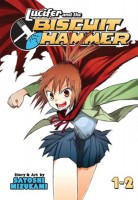My News and Reviews
Last week I posted two reviews at Experiments in Manga. The first review of was of Ajin: Demi-Human, Volume 1 written by Tsuina Miura and illustrated by Gamon Sakurai. It’s a manga with a rather dark atmosphere that deals with immortals, which is right up my alley. The first volume was a good start to the series; I’m looking forward to seeing how it continues to develop. The second review was of The Legend of Bold Riley, created by Leia Weathington and illustrated by a number of different artists. The review was actually the final review in my Year of Yuri project, so over the weekend I posted a wrap-up for the project as a whole. Later this week, most likely on Friday, a poll will go live so that readers of Experiments in Manga can vote to help me select my next monthly review project.
I came across a few fun and interesting things elsewhere online last week, too. Mangabrog has a translation of a conversation between Katsuhiro Otomo and Takehiko Inoue from 2012. Kate Beaton posted the second part of her collection of comics based on Natsume Sōseki Kokoro (a novel that I’ve reviewed in the past). The Ceiling Gallery posted “Girl Talk”, an article about “the life, friends and music of manga author Okazaki Kyoko” which is well worth reading. Anna Madill, a professor at The University of Leeds, is currently conducting research into boys’ love fandom. If you’re an English-speaking boys’ love fan, please consider assisting her research by completing a brief BL Fandom Survey.
Quick Takes
 Lucifer and the Biscuit Hammer, Omnibus 1 (equivalent to Volumes 1-2) by Satoshi Mizukami. I really wasn’t sure what to expect from Lucifer and the Biscuit Hammer, but I ended up enjoying the first volume immensely. One morning, college student Amamiya Yuuhi wakes up to discover a talking lizard in his bed, requesting his help to protect a princess destined to save the world from an evil mage bent on destroying Earth by using a giant hammer floating in space. Despite his initial reluctance to get involved in the whole mess, Yuuhi decides to become her knight because of one simple fact: The only reason Samidare (who need little protection) wants to save the world is so that she can destroy it herself. Much like its title, Lucifer and the Biscuit Hammer is kind of strange. Both the characters and story are quirky, a little goofy, and rather bizarre. The manga is also quite a bit darker than it first appears; the characters are all revealed to have twisted pasts and tragedies to work through. It’s particularly interesting to see protagonists who are closer to being supervillians than superheros. I’m still not entirely sure where Lucifer and Biscuit Hammer is heading, but I’m really looking forward to reading more of the series and finding out.
Lucifer and the Biscuit Hammer, Omnibus 1 (equivalent to Volumes 1-2) by Satoshi Mizukami. I really wasn’t sure what to expect from Lucifer and the Biscuit Hammer, but I ended up enjoying the first volume immensely. One morning, college student Amamiya Yuuhi wakes up to discover a talking lizard in his bed, requesting his help to protect a princess destined to save the world from an evil mage bent on destroying Earth by using a giant hammer floating in space. Despite his initial reluctance to get involved in the whole mess, Yuuhi decides to become her knight because of one simple fact: The only reason Samidare (who need little protection) wants to save the world is so that she can destroy it herself. Much like its title, Lucifer and the Biscuit Hammer is kind of strange. Both the characters and story are quirky, a little goofy, and rather bizarre. The manga is also quite a bit darker than it first appears; the characters are all revealed to have twisted pasts and tragedies to work through. It’s particularly interesting to see protagonists who are closer to being supervillians than superheros. I’m still not entirely sure where Lucifer and Biscuit Hammer is heading, but I’m really looking forward to reading more of the series and finding out.
 My Japanese Husband Thinks I’m Crazy by Grace Buchele Mineta. A companions of sorts to her blog Texan in Tokyo, My Japanese Husband Thinks I’m Crazy! is a collection of autobiographical comics and essays about Mineta’s life in Japan, her work as a freelancer, and her intercultural marriage. I’ll admit, I haven’t actually read much of Texan in Tokyo, but the comics made me laugh, so I decided to pick up the book. Some of the material collected is new to the volume while other material comes directly from the blog. My Japanese Husband Thinks I’m Crazy! is a wonderfully amusing and at times even enlightening collection. The main “characters” are Mineta herself, her salaryman husband Ryosuke, and Marvin—a talking rabbit who’s a figment of her imagination, the result of “stress, coffee, and loneliness from being a freelancer in Tokyo.” The comics are sweet, charming, and short, generally only a single page consisting of a few panels. Many of the comics are personal in nature, but some of Minata’s experiences are certainly shared by other foreign residents and visitors to Japan. My Japanese Husband Thinks I’m Crazy! is a fun way to learn little tidbits about Japan and Japanese culture.
My Japanese Husband Thinks I’m Crazy by Grace Buchele Mineta. A companions of sorts to her blog Texan in Tokyo, My Japanese Husband Thinks I’m Crazy! is a collection of autobiographical comics and essays about Mineta’s life in Japan, her work as a freelancer, and her intercultural marriage. I’ll admit, I haven’t actually read much of Texan in Tokyo, but the comics made me laugh, so I decided to pick up the book. Some of the material collected is new to the volume while other material comes directly from the blog. My Japanese Husband Thinks I’m Crazy! is a wonderfully amusing and at times even enlightening collection. The main “characters” are Mineta herself, her salaryman husband Ryosuke, and Marvin—a talking rabbit who’s a figment of her imagination, the result of “stress, coffee, and loneliness from being a freelancer in Tokyo.” The comics are sweet, charming, and short, generally only a single page consisting of a few panels. Many of the comics are personal in nature, but some of Minata’s experiences are certainly shared by other foreign residents and visitors to Japan. My Japanese Husband Thinks I’m Crazy! is a fun way to learn little tidbits about Japan and Japanese culture.
 Yakuza in Love, Volumes 1-3 by Shiuko Kano. Despite being one of the boys’ love creators with the most manga published in English, which I assume would be an indicator of her popularity, I generally find Kano’s work to be fairly hit-or-miss with me. Sadly, Yakuza in Love largely falls into the miss category. The short series is one of Kano’s earliest works, and it shows. The pacing is all over the place and frequently rushed, the action is difficult to follow, the sex and supposed romance doesn’t always mesh with the story, the plot doesn’t distinguish itself from any other generic yakuza-themed boys’ love manga, and she can’t quite seem to decide if she’s going for comedy or drama. She probably should have stuck with the humor—as a whole, Yakuza in Love simply doesn’t work as well when it takes itself too seriously. It wasn’t all bad, though. Just perhaps a little too ambitious. The best part of Yakuza in Love is actually all of the extras at the end which take up the last half of the third volume. Kano relaxes and just has fun with her characters, actually giving them more depth while parodying her own story. As a result, the extras end up being much more enjoyable.
Yakuza in Love, Volumes 1-3 by Shiuko Kano. Despite being one of the boys’ love creators with the most manga published in English, which I assume would be an indicator of her popularity, I generally find Kano’s work to be fairly hit-or-miss with me. Sadly, Yakuza in Love largely falls into the miss category. The short series is one of Kano’s earliest works, and it shows. The pacing is all over the place and frequently rushed, the action is difficult to follow, the sex and supposed romance doesn’t always mesh with the story, the plot doesn’t distinguish itself from any other generic yakuza-themed boys’ love manga, and she can’t quite seem to decide if she’s going for comedy or drama. She probably should have stuck with the humor—as a whole, Yakuza in Love simply doesn’t work as well when it takes itself too seriously. It wasn’t all bad, though. Just perhaps a little too ambitious. The best part of Yakuza in Love is actually all of the extras at the end which take up the last half of the third volume. Kano relaxes and just has fun with her characters, actually giving them more depth while parodying her own story. As a result, the extras end up being much more enjoyable.
 Monthly Girls’ Nozaki-kun directed by Mitsue Yamazaki. Based off of an ongoing yonkoma manga series by Izumi Tsubaki, Monthly Girls’ Nozaki-kun is an absolutely delightful twelve-episode anime series. The titular Nozaki is a tall, stoic, and slightly oblivious high school student who, despite what most people would assume from his appearance, also happens to be a published shoujo mangaka. Sakura has a crush on Nozaki, but when she tries to confess her love to him she somehow winds up as one of his assistants instead. Monthly Girls’ Nozaki-kun is a very funny and enjoyable series which freely plays around with shoujo manga tropes and character types. Nozaki finds inspiration for his manga from the other students at school, usually in slightly unexpected ways. He’s also amassed a handful of assistants in addition to Sakura, all with their own quirks and relationship problems which provide plenty of material for Nozaki to work with which eventually ends up in his manga. For the most part the anime tends to be fairly episodic, though there are several recurring characters and running jokes. Overall, the series is a tremendous amount of fun with a large cast of likeable characters.
Monthly Girls’ Nozaki-kun directed by Mitsue Yamazaki. Based off of an ongoing yonkoma manga series by Izumi Tsubaki, Monthly Girls’ Nozaki-kun is an absolutely delightful twelve-episode anime series. The titular Nozaki is a tall, stoic, and slightly oblivious high school student who, despite what most people would assume from his appearance, also happens to be a published shoujo mangaka. Sakura has a crush on Nozaki, but when she tries to confess her love to him she somehow winds up as one of his assistants instead. Monthly Girls’ Nozaki-kun is a very funny and enjoyable series which freely plays around with shoujo manga tropes and character types. Nozaki finds inspiration for his manga from the other students at school, usually in slightly unexpected ways. He’s also amassed a handful of assistants in addition to Sakura, all with their own quirks and relationship problems which provide plenty of material for Nozaki to work with which eventually ends up in his manga. For the most part the anime tends to be fairly episodic, though there are several recurring characters and running jokes. Overall, the series is a tremendous amount of fun with a large cast of likeable characters.

Speak Your Mind